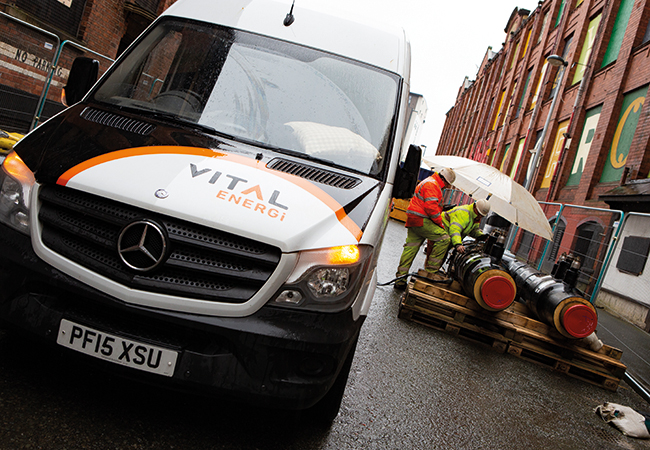
Leeds Town Hall, City Art Gallery and Central Library are connected to the Leeds Pipes heat network
In six years, Leeds City Council has developed one of the UK’s first modern city-wide heat networks.
Taking heat from the nearby Leeds recycling and energy recovery facility (RERF), the Leeds Pipes heat network, delivered by Vital Energi and developed by Ener-Vate, has expanded at an average rate of 5km of pipework a year, to reach 30km this year.
There are two energy centres. The Cross Green energy centre takes waste steam from RERF and converts it into low-temperature heat and hot water and a second at Saxton Gardens houses gas boilers and is designed to meet peak demand and add resilience.
Leeds Pipes recently celebrated its 2,500th residential connection and, in 2023, was calculated to have cut carbon from buildings by 6,000 tonnes.
Leeds Pipes has pioneered many of the concepts that are now becoming standard and it offers a glimpse into the potential future for such networks – the delivery of which will be turbocharged over the next two years, when the Energy Act 2023 gives the government powers to implement zoning in England and remove much of the red tape that can hold up such projects.
One of the core tools Leeds Pipes uses to facilitate delivery across the city centre is a local development order (LDO). It works with council planning policy to mandate the connection of buildings to heat networks (see panel).
Local development orders
Local development orders (LDOs) benefit developers and building owners, who no longer need to apply for planning for below-ground and small above-ground works associated with their connection.
The Leeds LDO, covering 1,045 hectares, is restricted to land within the adopted public highway, council-controlled land, and other large institutions, such as universities and hospitals. In total, the length of public highway incorporated within the LDO is 1,914km.
The LDO can be renewed to facilitate future phases, a process that Leeds has already undertaken.
It was designed to work in lockstep with the council’s EN4 Planning Policy, which mandates that a district heating network solution must be considered for developments of a certain scale. This policy has resulted in various buildings being required, through their planning approval, to connect to the network.
The approach used by Leeds Pipes will be incorporated into heat network zoning and the planning process will be used to encourage new developments to connect to a network where practical.
Leeds Pipes was one of the first in the UK to follow the CIBSE CP1 Heat networks: Code of Practice (HNCOP) (2020); all developments will need to adhere to this once the Heat Network Technical Assurance Scheme (HNTAS) is published in 2025. This scheme will ensure mandatory compliance with minimal technical standards.
By meeting the requirements of the CP1, the 30km of pipework at Leeds Pipes has proven reliable, and planned expansion has been simple. The process of integrating other networks in the future is also anticipated to be relatively straightforward.
David Wilkinson, design director, pre-construction, at Vital Energi Utilities, is on the HNTAS steering group. He says the scheme will ensure all heat networks are designed, delivered, operated and maintained to the same high level, bringing increased consumer confidence.
‘The ambition is that, if all projects are delivered to the same standard and similar specifications, then smaller networks can connect to each other, or be absorbed into larger networks,’ Wilkinson adds.
This was the case on the Torry Heat Network in Aberdeen, which saw the Heatnet system connect to the city-wide scheme.
‘Crucially, where the CP1 relied on consultants and clients to be conscientious, HNTAS is legislation, and there are likely to be serious consequences for failing to adhere to its standards,’ says Wilkinson.
150 years of building variations
Older generations of district heating schemes thrived on consistency, proving themselves ideal for new-build projects. However, there was a worry in the industry that they would be unsuitable for older buildings with poor thermal insulation and high infiltration rates.
The Leeds Pipes network has demonstrated the versatility of third-generation heat networks, providing heat between 100°C and 70°C.
At one end of the spectrum, there is the Grade II-listed town hall, completed in 1853, and, at the other end, there are numerous buildings that were erected in the past few decades, as well as new builds constructed more recently.
Add commercial buildings – including Leeds Beckett University, St James’s University Hospital and the Combined Court Centre – and more than 2,500 homes, and it would be hard to find a network with more diversity of demand.
Connecting a Grade II-listed building and a new office block is challenging; consideration has to be given to everything from thermal characteristics to current heating systems.
Designers were able to meet this challenge by ensuring that those requiring the highest temperatures influenced the network generation and distribution temperature. Some had their existing heating systems modified to make them more suited to a district heating connection, such as reducing low-temperature hot water (LTHW) flow temperatures to serve heat emitters, while still offsetting heat losses and ensuring thermal comfort.

Some buildings also required: the conversion of constant volume systems to variable volume, to ensure low LTHW return temperatures; the replacement of pumps with inverters; amended controls logic; and the installation of pressure-independent balancing control valves.
There is a push to create more optimised systems and, in particular, deliver optimally sized projects. When it came to sizing, the old British standards could put you on the right street; then there was a big step forward with the HNCOP, which put you in the right house.
By using benchmarks, combined with Vital’s database of real-world use, models are more accurate, effectively eliminating the risk of oversizing.
A key factor in heat network optimisation is the use of diversity in design. By focusing on the maximum expected load, rather than the maximum possible load, Vital has been able to create better-sized projects across all components, including pipework, pumps, heat exchangers and energy-centre footprint. Crucially, this was all done while maintaining resilience.
By understanding usage patterns of more than 30,000 connected heat users on 100+ heat networks, an evidence-based diversity calculation can now be applied to fully optimise network design.
Furthermore, this data-driven methodology is encouraged in the latest CP1. The approach avoids the common pitfalls that come with oversizing, such as unnecessarily large equipment, under-used assets, higher heat losses and the associated capital and operational expenditure that entails.
The Leeds Pipes network was sized for future phases based on the council’s plans for expansion. Now that the system has additional heat loads, exceptional efficiencies are being achieved .
As the UK strives to meet its net zero targets, Leeds Pipes illustrates what can be achieved with the tools already at our disposal. Other initiatives, such as HNTAS and heat network zoning, have the potential to usher in a revolution in the way we design, deliver and operate such networks.
About the author
Lee Moran is design director –operations at Vital Energi Utilities
